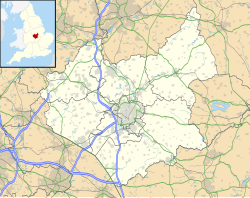| Towers Hospital | |
|---|---|
 Original main block with superintendent's residence above, Towers Hospital | |
| Geography | |
| Location | Humberstone, Leicestershire, England |
| Coordinates | 52°38′59″N1°05′28″W / 52.6498°N 1.0911°W |
| Organisation | |
| Care system | NHS |
| Type | Specialist |
| Services | |
| Emergency department | N/A |
| Speciality | Psychiatric Hospital |
| History | |
| Former names | Victoria House, George Hine House |
| Opened | 1869 |
| Closed | 2013 |
| Links | |
| Lists | Hospitals in England |
| Other links | https://www.youtube.com/watch?v=pIvozSRZA3c |
The Towers Hospital was a mental health facility in Humberstone, Leicestershire, England. The administration building, which became known as George Hine House, is a Grade II listed building. [1] The property, which was originally a home on a family estate owned by the Broadbent family was transformed into what would become the hospital after being sold to the Leicester Borough Council in 1862. [2] Adjacent to the main building is Benjamin Court which is named after the original owner, Benjamin Broadbent. [3]
